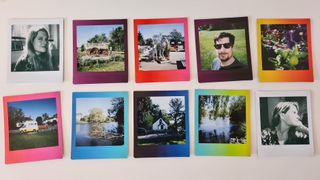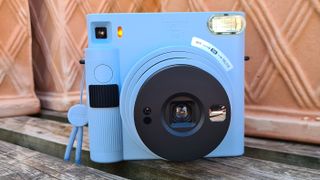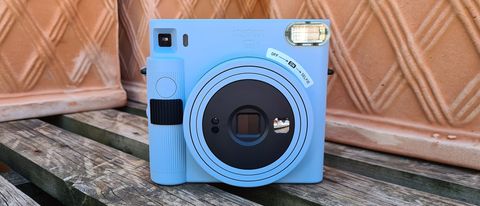TechRadar Verdict
The Instax SQ1 makes Fuji's square format instant cameras even more affordable, at the expense of features. That makes it ideal for snapping away without thinking about shooting modes, but creatives may miss the versatility of the pricier SQ6.
Pros
- +
Point-and-shoot simplicity
- +
Square photos are a fine size
- +
Delivers punchy, vibrant snaps
Cons
- -
No advanced shooting modes
- -
No tripod thread
- -
Non-rechargeable batteries
Why you can trust TechRadar
The Fujifilm Instax SQ1 is a new middle ground in its instant camera range. The best place to start with Instax has traditionally been the Fujifilm Instax Mini 11 (or Instax Mini 9 predecessor), its simplest and most affordable model. The downside? Those cameras limit you to Instax Mini film – and while their rectangular photos are fun, the more expensive Fujifilm Instax SQ6 and its Instax Square film offer the more authentic retro experience.
Film: Fujifilm Instax Square
Lens: fixed-focus, 65.75mm f/12.6
Shooting modes: Auto, selfie/close-up
Viewfinder: optical, fixed
Battery: 2xCR2, around 100 shots
The Instax SQ1 offers a blend of the two experiences, combining the ease of use of Fuji's more basic models (including the handy auto exposure system introduced on the Instax Mini 11) with larger, square format film. Our review will help you decide whether the SQ1 deserves its place on our best instant camera list.
Each 86x72mm (3.4x2.8in) print has a 62x62mm (2.4x2.4in) image area, with packs of ten typically costing £8/$8/$AU24. Previously Instax Square was only available as color film, but now Fuji finally offers a monochrome option. Colorful Rainbow frame packs complete the expanded line-up.

The Instax SQ1 bears more than a passing resemblance to the pricier SQ6, with square dimensions dominated by the large lens barrel. It's just as sizable, with no way you'd fit one in a pocket, so it's nice to see a wrist strap bundled in the box. Vibrant Glacier Blue, Terracotta Orange and Chalk White color options reinforce this camera's "fun-first" approach.
The SQ1 is built entirely from matte plastic, which helps cut down on costs, but has a decent heft to it once loaded with film and batteries. CR2 batteries are more expensive than AAs, but only need replacing every ten or so packs of film.
Functionality is stripped back completely, the twisting lens barrel both turning on the camera and automatically activating the flash. There's no way to disable it. Twisting further switches from regular to close-up shooting, which is largely for selfies – there's even a tiny mirror built into the lens barrel for composition.




The only other button is the shutter release, which is built into the chunky grip on the right side just below the viewfinder. This camera is very much designed for right-handed use.
A flip-down door at the rear holds the film pack, with a small counter in the grip showing how many shots you have left so you don't waste a half-finished pack by accidentally opening the door too soon. Prints are ejected out the top of the camera, and can take around three to ten minutes to fully develop – slightly faster than Polaroid's physically larger I-Type film.




The Instax SQ1's viewfinder sits off-centre, but still gives a good representation of what the lens sees, and the new auto exposure system ensures fewer snaps are washed-out or over-exposed.
This was all too common in the Instax Mini 9, but here even tricky lighting conditions produced usable shots. The way the automatic flash helps balance out indoor scenes is on par with the Instax Mini 11 – only here you're getting a significantly larger print thanks to the square format film.







You'll still notice overblown highlights in some of our sample images, but this is largely a characteristic of the film. Instax usually delivers pastel-like colors mixed with dark shadows, albeit in a more true-to-life manner than some rival film formats, and that is very much the case here.
The fixed focus lens makes the SQ1 best suited to portraits and middle-distance subjects, with landscapes appearing far softer. The camera offers no visual clue you're shooting in selfie mode from the rear, either, so it's important to remember to twist the lens back. Otherwise longer-distance snaps will appear even more blurry and out-of-focus.
By making larger format instant film more readily available to those looking to get started with the medium, the Instax SQ1 gives beginners greater choice when it comes to choosing their first camera.
It's undeniably simple, which could be a turn-off for more creative photographers, but still delivers punchy photos with the trademark charm we've come to expect from instant. It's hard to beat for sheer value, filling a price gap between the basic Instax Mini 11 and more advanced Instax SQ6 without too many compromises.
Should I buy the Fujifilm Instax SQ1?

Buy it if...
You just want to point and shoot
The Instax Square SQ1 is about as simple as instant cameras get, with no extra modes or controls to confuse novice users.
Value matters above all else
It may be basic, but the Instax SQ1 is also one of the most affordable instant cameras around. Combined with well-priced Instax Square film, you won't have to spend very much to take lots of instant photos.
You're a square at heart
Instax film is available in smaller Mini and larger Wide format as well as Square, but the SQ1 can only shoot the latter. If you're happy with those dimensions, this is a great starting point.
Don't buy it if...
You want to get more creative
Move a little further up the Instax range and there are cameras with shooting modes like double exposure and useful extras like a tripod thread that allow for more original shots.
You value build quality and materials
The Instax SQ1 feels every bit the inexpensive camera, with a fully plastic construction. Slightly pricier Instax cameras use higher quality materials, which gives a more premium look.
You don't like wasting film
Even with the new auto exposure system, the SQ1's lack of autofocus can make it tricky to take sharp photos - unless you're prepared to experiment and accept that some of your shots may be a little blurry
- These are the best instant cameras you can buy right now
Most Popular



